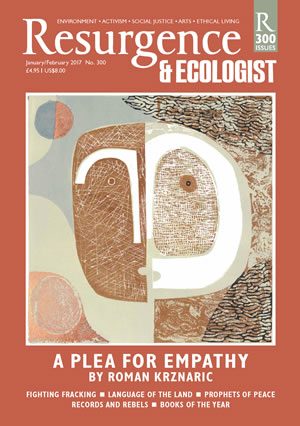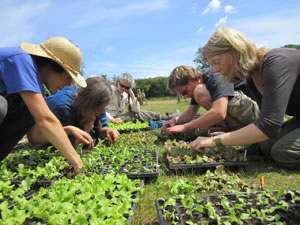Right from Schumacher College’s inception as a centre for nature-based education, personal transformation and collective action, the gardens have been integral to the vision of Satish Kumar and co-founders. In keeping with Tagore's view that nature is our teacher, different areas within the gardens have been created as spaces for contemplation and relaxation, food growing and ecologically-minded horticultural practices.
To help incarnate the college ethos of ‘whole person learning’ the last few years have seen a significant expansion of the food growing areas and subsequently the amount of food grown on site currently being used in the kitchens. We have also developed our own 6 month residential taught programme of ecological food growing (the Schumacher Practical Residency in Sustainable Horticulture) that allows people to experience the richness of college life and its experiential learning of growing food in a resilient and regenerative way. For many of our resident horticulture students this has been a life-changing experience.
The gardens have been through several phases. Initially mostly ornamental with a small herb garden, subsequently several areas were planted as forest garden, along with fruit trees and bushes. With the advent of horticultural teaching at the college, a series of no dig vegetable beds were added.
Now, with the development of the 6 month residential sustainable horticulture course, we have two new innovative growing spaces where students can learn sustainable horticulture by practising it and reflecting on that practice.
The first is by the Old Craft Education building and is a circular raised no-dig garden (where we are modifying to suit our situation, Emilia Hazelip's synergistic agriculture), a fruit area and three poly tunnels. In this garden we have a large wildlife pond and two small ponds for our Indian runner ducks.
Synergistic Gardening was a type of food growing practised by Emilia Hazelip, inspired by Masanobu Fukuoka's natural gardening. The main tenets are to follow the principles underlying natural ecosystems and plant communities when designing the system, in other words to create spaces to maximise the number of key ecological interactions; relying on soil life and plant debris to replenish soil fertility and maintain structure; to not dig, nor apply any pesticides or herbicides; to use polycultures rather than monoculture and to keep the soil covered with permanent, preferably living, organic mulch.
This has gone well. We have created a much admired, productive, beautiful garden, and it has also presented us with a few challenges. The main one, predictably, has been slugs. Emilia Hazelip strongly advocated putting any part of the plant that you are not eating down on the beds as residue mulch and to leave the roots in the ground (unless the roots are the crop as with parsnips, carrots etc).
We did this and the crop debris and straw mulch created a perfect habitat for slugs. We have tipped the balance in our favour by encouraging frogs, toads and other predators, including our much loved runner ducks, who proffer eggs and entertainment as well.
As an experiment this winter, instead of crop debris being left, we are removing and composting it and growing an annual overwintering green manure on the beds to see if this causes us fewer slug problems.
Our other big project and main food tending area is a new five and a half acre agroforestry field, named Henri's field after Henri Bortoft. Here we are using alley cropping techniques, creating a nut orchard, a forest garden (designed to keep complexity whilst allowing for relative ease of harvest), and a craft and cut flower garden. Also there are two wildlife ponds. This garden will eventually house a second flock of chickens and be an important ‘people space’ for all types of outdoor learning.
The large increase in the amount of vegetables used in the college kitchens now coming from the gardens is a significant change. The cooks at the college have been remarkable in their commitment to the gardens and to the use of our produce even the more unusual perennials such as Yacon, and to pickling and preserving any gluts. The increase in college grown food has engaged many of the students; who have helped with blanching and freezing as well pickling beets and processing quinoa. This is, perhaps, just one of the many benefits that the expansion of the gardens has bought to college and community life.
Food is essential to our physiological survival but also our emotional and spiritual well-being. When we are cooked for we usually feel cared for. It is the universal way to concretely express hospitality and love. Only one step back from this is to have your food grown and harvested for you. Yet for many people it is not perceived this way.
The food we eat is a gift of the universe but for too many people in developed nations it is a commodity bought from the shops, to be possessed and purchased (all too often thrown away) rather than received and honoured.
We all relate to food but the nature of that relationship is very different if you have grown, harvested, prepared and cooked it yourself, or you have been in close contact with those that have done this. I am reminded of the way wealthy landowners used to hide walled kitchen gardens out of sight of the main house, distancing themselves from the work. Are we any different today? We now let the agribusinesses and supermarkets hide away the business of food production.
But distance and lack of knowledge produce disengagement and a failure of relationship. This is hurting all of nature.
It can be difficult for me now to recall what it was like to feel this disengagement; but of course the problem was that l did not feel it. It is only really with the engagement I have since practising horticulture that I have something to contrast the norm with. If the entire world is monochromatic, it is hard to conceive of colour. If you grow up in a world of food processed and packaged before you meet it, then why worry about organic matter levels in agricultural soils, or who ‘owns’ seed diversity?
Exposure to, opens up the possibility of relationship with. For me the passion I developed for ornamental gardening and all its beauty quickly and dramatically opened my eyes to plants, their evolution; astonishing diversity; resourcefulness and our complete dependence on them. Having left behind a career in Psychiatric practice I found much personal healing in the company and generosity of plants and their cycles. When I gained knowledge of the harmful effects of certain of our gardening practices, I felt this beauty and all it gave me to be at profound risk, and I wanted to be part of some different way of growing. This led me to train for three years at the Royal Botanic Gardens Kew. Here where plants are seen as major players, I became interested in food growing and learnt of the many problems with our current way of providing for ourselves. Following this path bought me to work in the Schumacher Gardens and co-ordinate the Practical Residency at the College. I wanted to be able to work tending plants, and learning and teaching resilient ways of doing this, in a context where this is seen as an important spiritually fulfilling practice; a practice that fosters a depth of presence in the world, and so keeps us from falling into hubris and its chilling ripple effect.
But what does it mean to be in relationship to nature? It is a tautology to want to be in relationship to nature, since we are part of nature; but it is the felt awareness that people value and crave, because it can come with a sense of perspective, humility, of being part of something far, far greater than oneself and at times a sense of the numinous. However, even amongst professed nature lovers, there can still be a disconnection from nature in the form of food. We can often see the countryside as a place of leisure, escape and peace. This is, of course, a way of relating, but it is impoverished if it stays at that level. Then we are like the rich Estate owners wanting our picturesque landscapes to be unsullied by the kitchen garden and of course the farm.
Yet the very essence of our awareness of our ontological connection and thus interdependence on nature, bids us to think about how we meet our needs in this relationship, a primary one being our need for food. We, in our developed world, know at one level that we depend on plants for our very life but we devalue and side line it in so many ways. Compare this to the value we put on housing and the contrast is stark. We expect houses to be expensive, yet we have come to expect cheap food. Yet both shelter and sustenance are basic needs. Both are gifts.
Yet how do we heal the rift, repair the relationship? I think the answer is simply to start gardening.
That is why the gardens at the college are not an 'add on', but that whole person learning, deep ecology, systems thinking, transformation all require grounding in concrete interaction with and within the nature for them to be truly transformational. You cannot, I believe, garden thoughtfully and not come to see that there is no separation between us and our environment, to see that we are constitutive of nature, but thankfully not its totality.
With such understanding and insight comes care and compassion. Care for oneself is impossible without care for the earth. The appetite is there, it may need reawakening, but it is there and the more opportunities we create for this interaction with how nature meets our part of herself, the more hope I have in our future. That is why I feel the college would be incomplete without its gardens, the Practical residency and its students.








